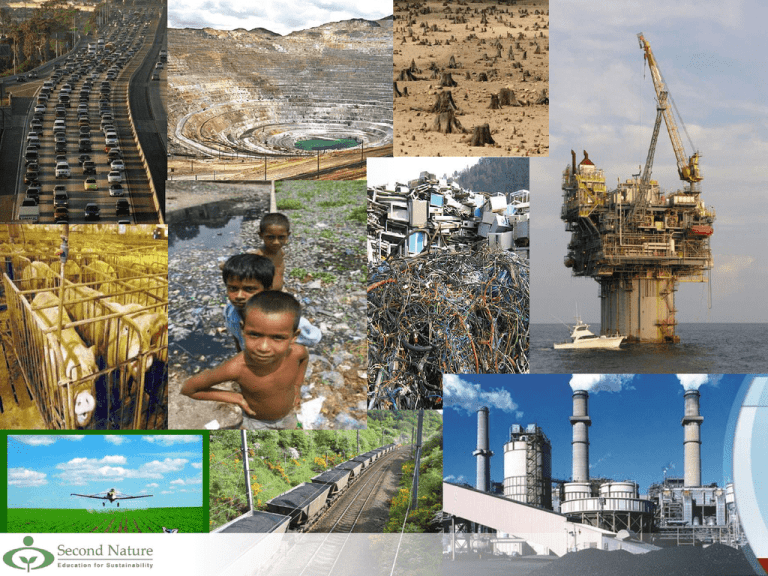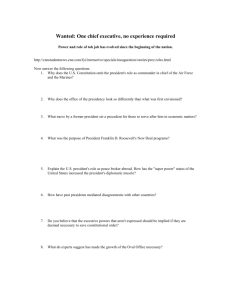
Chart Sources: Meadows, D.H., Meadows, D.L., Randers, J. and Behrens III, W.W. (1972)
The Big Question
How do we create a decent quality of
life for all current and future humans on
a planet whose capacity to support life
is precarious?
Sustainability Dimensions
• Health
• Social justice, cultural diversity and strong
communities
• Economic opportunity for all
• Restore and sustain the life support system
Physical Reality
Biosphere
Society
Economy
How did we get here?
Humans dominant and separate from nature
Earth: infinite giver
Linear thinking
Increased consumption = success
SYSTEMS DESIGN
FAILURE!
Making the “invisible”
“visible”
•
•
•
•
Systemic life cycle impacts
True cost pricing & accounting
Better measures of well-being
Timely ecological and social signals
A Change in Mindset
Problem Solving to Creating
Fluorishing and Sustainable Human
Society
Energy Efficiency
& Renewable Energy
Circular Production
Nature’s Interest
A New Human Story?
Sufficiency: Needs over wants
Community
Cooperation and collaboration
Caring for all life: golden rule
Sustainable economy
Higher Education Modeling Sustainability
as a Fully Integrated Community
Transforming Higher Education
•
•
•
•
•
Content of learning
Context of learning
Process of learning
Institutional Practice of Sustainability
Partnerships with Local & Regional Communities
The American College & University
Presidents’ Climate Commitment
(ACUPCC)
Climate Leadership in Higher Education
www.PresidentsClimateCommitment.org
(c) 2009 Presidents Climate Commitment. All rights reserved.
The ACUPCC Initiative
•
•
•
•
•
•
Led by presidents & chancellors
660 + institutions
50 States & one-third of student population
Action plan for climate neutrality
Research & education
Public accountability
www.PresidentsClimateCommitment.org
(c) 2009 Presidents Climate Commitment. All rights reserved.
The Sequence of Success
1608
GHG
Inventorie
s
Submitted
Total Signatories Annually
900
Cumulative Signatories (739)
800
Net Signatories (660)
700
600
New Signatories (732)
Withdrawals & Removals (79)
Cumula ve Signatories (721)
500
Net Signatories (675)
400
New Signatories (721)
476
Withdrawals (46)
Climate
Action Plans
Submitted
300
200
100
0
In 2006
2006
In 2007
2007
In 2008
2008
In 2009
2009
In 2010
2010
In 2011
2011
Summary of Progress
ROLE MODELING SOLUTIONS ON CAMPUS
207 Signatories have reduced
1,621,000 MTCO2e
Average of 7,830 metric tons per institution
Renewable Energy on ACUPCC Campuses
298 signatories produce 295 million kwh of renewable energy annually.
160 Signatories have purchased > 1.4 Billion kwh Renewable Energy Credits.
www.PresidentsClimateCommitment.org
(c) 2009 Presidents Climate Commitment. All rights reserved.
Climate Neutrality Target Dates
180
160
140
120
100
80
60
40
20
0
By 2022
By 2032
www.PresidentsClimateCommitment.org
By 2042
Selected 2050
Beyond 2050
(c) 2009 Presidents Climate Commitment. All rights reserved.
Summary of Progress
CURRICULUM
•
•
•
•
•
167 signatories offer 10,203 sustainability focused courses.
198 have undergraduate degrees in sustainability.
112 have graduate degrees in sustainability.
115 have a degree program that includes sustainability learning outcomes.
51 Associate colleges offer degrees or certificates in Solar, Wind, Energy
Efficiency, Sustainable Agriculture, Food & Land Use, Transportation & Fuels,
Green Building, General Sustainability.
• 112 provide faculty incentives for sustainability integration.
www.PresidentsClimateCommitment.org
(c) 2009 Presidents Climate Commitment. All rights reserved.
Summary of Progress
FINANCIAL SAVINGS
Funding Secured from Outside Sources for Climate Action Plan Implementation:
112 signatories
$209,032,131 Total
19 Associate colleges secured
34 Baccalaureate colleges secured
29 Master’s granting institutions secured
26 Doctorate granting institutions secured
4 Special Focus schools secured
www.PresidentsClimateCommitment.org
• 13 Associate colleges
$24,039,214
$20,186,697
$92,282,579
$70,078,141
$2,445,500
(c) 2009 Presidents Climate Commitment. All rights reserved.
Summary of Progress
FINANCIAL SAVINGS
• 67% of signatories report CAP implementation has saved money.
171 institutions saved total of $105 Million
• Funding Secured from Outside Sources
112 signatories secured total of $209,032,131
www.PresidentsClimateCommitment.org
(c) 2009 Presidents Climate Commitment. All rights reserved.
Reduce 80,000 tons
/ year
Save $2,000,000
per year
BALL STATE UNIVERSITY
Total Reduction
80,000 tons / year
Total Savings $2,000,000
per year
Produces 97% of
electricity
Saves $700,000
per year
MOUNT WACHUSETT COMMUNITY COLLEGE
Reduce emissions 60%
below 2000 levels by 2012
Carbon Neutral Target
Date 2019
Save $4 million
Produce 6.5 million
kwh / year
per year
BUTTE COLLEGE
First Institution to
Become Grid Positive
Total Savings $50-75
Million over next 15 years
Summary of Progress
ACUPCC & STARS
www.PresidentsClimateCommitment.org
(c) 2009 Presidents Climate Commitment. All rights reserved.
The Deeper Meaning of the ACUPCC
• Strategic imperative
• Key lens for measuring success
• Institutional & cultural focus on all elements
of sustainability
• A strong visible signal for society
www.PresidentsClimateCommitment.org
(c) 2009 Presidents Climate Commitment. All rights reserved.
Institutionalization
•
•
•
•
•
•
•
Integral to University Mission
Integral to Academic and Campus Master Plan
Sustainability Policies and Measurement
Rewards, Incentives & Staff Development
Development Priority/Alumni Tracking
Communications & Marketing
Collaboration with Other Sectors
Scaling Up the Movement
• Making the case: sustainability = success for HE and
society
• Inter-institutional collaboration
- Energy
- Financing
- Curriculum
- Supply chain management
- Faculty and staff development
• National effort on faculty and staff development
• Partnerships with business and communities
• Influencing federal policy and funding
“I have been impressed with the urgency of
doing. Knowing is not enough: we must
apply. Being willing is not enough: we must
do.”
Leonardo da Vinci
Communication is to Sustainability
What
Location is to Real Estate
A Perspective
“We are like tenant farmers chopping down the
fence around our house for fuel when we should
be using Nature’s inexhaustible sources of
energy - sun, wind and tide. ... I'd put my money
on the sun and solar energy. What a source of
power! I hope we don’t have to wait until oil and
coal run out before we tackle that.”
www.PresidentsClimateCommitment.org
(c) 2009 Presidents Climate Commitment. All rights reserved.
Source?
Thomas Edison, 1931
Conversation with Henry Ford & Harvey
Firestone
http://en.wikipedia.org/wiki/Harvey_Firestone
www.PresidentsClimateCommitment.org
(c) 2009 Presidents Climate Commitment. All rights reserved.
Resources
Second Nature
www.secondnature.org
American College & University Presidents’ Climate Commitment
www.presidentsclimatecommitment.org
Association for the Advancement of Sustainability in Higher
Education
www.aashe.org
American Association of Community Colleges SEED Center
http://theseedcenter.org
Curricular Resources
“Education for Climate Neutrality and Sustainability”
“Advancing EFS: Teaching the Concepts of Sustainable
Building to All Students”
www.presidentsclimatecommitment.org/resources/ed
ucation
“Sustainability Curriculum in Higher Education: A Call to
Action”
http://www.aashe.org/files/A_Call_to_Action_final%
282%29.pdf
The Commitment
First 2 Months
Within
1 Year
Within
2 Years
Within
3 Years
Within
4 Years
Create institutional
structures & initiate
two of seven
suggested actions
Complete
GHG
emissions
inventory
Develop
institutional
climate action
plan
*Complete
updated
GHG
emissions
inventory
*Submit
Progress
Report on
Climate
Action Plan
*GHG inventories and Progress Reports are due every other year, ongoing
www.PresidentsClimateCommitment.org
(c) 2009 Presidents Climate Commitment. All rights reserved.
Process
Analysis framework
Use to prompt the expansion of the issues.
The World on the Edge book can help
define these points.
Climate
Change
Economic
Crisis &
Collapse
Fossil Fuel
Depletion
Sustainability
Framework
Climate
Stabilization
(Crisis)
Energy
Conservation,
Curtailment
and
Renewables
Plan A
Species
Extinction
Resources
Depletion
Economic
Stabilization
Sustainability
Framework
Food
Insecurities
(Responses)
Plan B
Population
Stabilization
See the worksheets with tables
listing the framework aspects.
Resource
Conservation
Restore
Natural
Systems
Faculty Development Program
•
•
•
•
•
•
•
Core group designated to coordinate and run
Workshops/seminars to expand faculty knowledge
Incentives for faculty participation
Accountability for new/revised curriculum
Mechanism for feedback/ongoing learning
Access to pedagogical resources
Communication and reporting to college community
Myths to Dispel
•
•
•
•
•
Sustainability is just another special interest
Sustainability is only environmental
Sustainability is secondary to mission
Sustainability will almost always cost more
Sustainability is largely a scientific and
technological issue
NJHEPS
NJHEPS
NJHEPS
NJHEPS
NJHEPS
NJHEPS
NJHEPS
NJHEPS
NJHEPS
NJHEPS
NJHEPS
NJHEPS
NJHEPS
NJHEPS
NJHEPS
NJHEPS
NJHEPS
www.PresidentsClimateCommitment.org
(c) 2009 Presidents Climate Commitment. All rights reserved.
Summary of Progress
Climate Neutrality Dates by Carnegie
Classification
www.PresidentsClimateCommitment.org
(c) 2009 Presidents Climate Commitment. All rights reserved.
Energy Efficiency Revolving Loan Fund
Bellevue College (WA)
$350,000
Grand Valley State University (MI)
$3.5 Million
Weber State University (UT)
$9 Million
www.PresidentsClimateCommitment.org
(c) 2009 Presidents Climate Commitment. All rights reserved.
Resource for Engaging Students
• Step by step tips for creating, maintaining &
evaluating a campus Eco-Rep program
• Descriptions of programs and best practices
• Case studies of successes and road blocks
• Activity, event, marketing & outreach examples
• Eco-Rep recruiting tools, sample job
descriptions, & other resources
www.PresidentsClimateCommitment.org
(c) 2009 Presidents Climate Commitment. All rights reserved.
Resource for Community Colleges
• Over 500 green curricular and other resources
• Detailed guides, toolkits and promising practices for faculty, staff, and administrators
• Professional development opportunities, including workshops, webinars, and mentoring
sessions (Coming in 2012)
www.PresidentsClimateCommitment.org
(c) 2009 Presidents Climate Commitment. All rights reserved.










